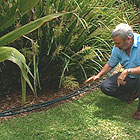Don’s Top Tips
Don’s great gardening tips have always been a feature of Burke’s Backyard over the last 17 years. Here are some of his favourites.
Hassle free hose
Coiling a garden hose makes it kink. Rather than coiling your hose, just run it up and back along the side of your garden beds. This makes it easy and quick to get out and use, and because it’s always straight it won’t kink.
A hose is very useful as a landscaping tool. It can be used to set out and create a natural, sweeping curve for a new garden edge. Pull the hose out (preferably on a warm day) and you’ll find the hose itself will tend to form a beautiful arc, which you can use as a guide for your edge.
Spades & shovels
Shovels and spades are designed to do different jobs in the garden. A shovel has a scooped blade and is used for moving garden material, such as mulch, sand and dirt. A spade is a cutting implement. It has a flat blade and is used for digging, cutting edges and dividing plants. Like all cutting implements, spades perform best when sharpened regularly.
The best way to sharpen a spade is by using a bench-mounted grinder. While the bench grinder is running, slide the bottom edge of the spade across until the edge is bevelled. (Hint: always wear safety gear when using power tools.) If you don’t have a bench grinder, use a sharpening stone.
Perfect pots
Many concrete, terracotta and ceramic pots only have one tiny, inadequate drainage hole in the centre of the base. Use masonry drill bits to drill additional holes, carefully working your way up from the small to the larger bits and gradually enlarging the holes. (For a large pot use masonry drill bits roughly 6mm (1/4″), 12mm (1/2″) and 25mm (1″) in size.)
Never buy a cheap potting mix. Instead, buy the best quality mix you can afford. Quality potting mixes display the Standards Australia ‘ticks’ on the pack. Potting mixes can contain dangerous micro-organisms, so read the safety directions on the label before opening, and take care not to inhale the air that comes out of the bag.
Choose tubes
The cheapest and best way to buy native plants is to purchase them in small pots known as ‘tubes’. Tubes are long and thin, with ridges running down the sides to encourage the roots of the plant to grow downwards, rather than coiling around the sides. Although tubestock is small compared to plants sold in say, 200mm or 8″ pots, the plants not only establish more quickly but they grow more vigorously for their entire lives.
Beating weeds
If your garden is chock-a-block with plants, there won’t be any room for weeds to grow! This is one of Don’s best low maintenance gardening tips. Use ground covers, mass plantings or mixtures of plants to fill up the garden and act as living mulch. An excellent ground cover to try is Australian native violet (Viola hederacea). Grassy plants such as mingo (Themeda australis var. Mingo) and lomandra (Lomandra longifolia) are also ideal for chocking up the garden. You’ll save time and money, because you won’t have to weed the garden or buy mulch.



